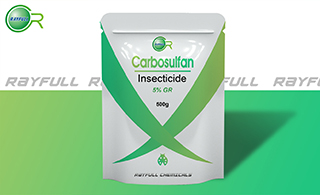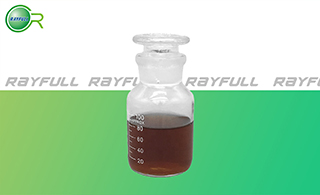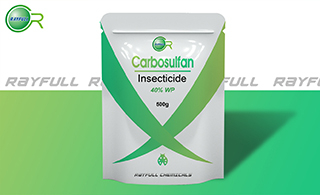Carbosulfan
    丁硫克百威 丁硫克百威
Introduction: Carbosulfan shown to be highly effective at killing a range of crop insect pests in field trials. Carbosulfan is insecticide for control of rice stem borer, millipedes, springtails, wireworms, caterpillars, flea beetles, colarado beetles, codling moth, scale insects, free-living nematodes in cotton, sugarbeet, sugarcane, potatoes, maize, vegetables, coffee, rice.
Common name: Carbosulfan
Another name: Marshal, Posse, Advantage, Marshall, Carbosulfan [ANSI:BSI:ISO], Dibutylaminosulfenylcarbofuran, Sheriff, Zaprawa Marshal
Chemical name: 2,3-dihydro-2,2-dimethylbenzofuran-7-yl (dibutylaminothio)methylcarbamate
Empirical formula: C20H32N2O3S
Structural formula:

Mol. Weight: 380.55 g/mol
CAS No.: 55285-14-8
Specifications
Leading Carbosulfan supplier
Carbosulfan 5% GR
Carbosulfan 250 g/L EC
Carbosulfan 25% WP
Carbosulfan 40% WP
Carbosulfan 480 g/L EC
Carbosulfan 90% TC
Packing:
BULK PACKING
Powder: 25kg/Bag, 25kg/Drum, 50kg/Drum etc.
Liquid: 200L/Drum, 20L/Drum, 10L/Drum ect.
SMALL PACKING
Powder: 1kg/Alu bag, 500g/Alu bag, 200g/Alu bag, 100g/Alu bag, 50g/Alu bag, 15g/Alu bag etc.
Liquid: 5L/Drum, 1L/Bottle, 500ml/Bottle, 250mL/Bottle, 100mL/Bottle, 50mL/Bottle etc.
Customerized packing label
Carbosulfan FAO standard
Professional registration
HAZARDS IDENTIFICATION
Hazard statement(s)
H301: Toxic if swallowed.
H317: May cause an allergic skin reaction.
H330: Fatal if inhaled.
H410: Very toxic to aquatic life with long lasting effects.
Precautionary statement(s)
P260: Do not breathe dust/fume/gas/mist/vapors/spray.
P261: Avoid breathing dust/fume/gas/mist/vapors/spray.
P264: Wash ... thoroughly after handling.
P270: Do not eat, drink or smoke when using this product.
P271: Use only outdoors or in a well-ventilated area.
P272: Contaminated work clothing should not be allowed out of the workplace.
P273: Avoid release to the environment.
P280: Wear protective gloves/protective clothing/eye protection/face protection.
P284: [In case of inadequate ventilation] Wear respiratory protection.
P301+P310: IF SWALLOWED: Immediately call a POISON CENTER/doctor/...
P302+P352: IF ON SKIN: wash with plenty of water.
P304+P340: IF INHALED: Remove person to fresh air and keep comfortable for breathing.
P310: Immediately call a POISON CENTER or doctor/physician.
P320: Specific treatment is urgent (see ... on this label).
P321: Specific treatment (see ... on this label).
P330: Rinse mouth.
P333+P313: IF SKIN irritation or rash occurs: Get medical advice/attention.
P391: Collect spillage.
P403+P233: Store in a well-ventilated place. Keep container tightly closed.
P405: Store locked up.
P501: Dispose of contents/container to ...
Supplemental Hazard Statements: none
MAMMALIAN TOXICOLOGY
Acute toxicity: 1) Acute oral LD50 for rat: 101 a.i.mg/kg. 2) Acute dermal LD50 for rat: 3700 a.i.mg/kg. 3) Inhalation LC50 (4 h) for rat: 0.61 a.i. mg/L. 4) Moderate - irritating to skin (rabbits). 5) Non- irritating to eyes (rabbits). 6) Not a skin sensitiser (guinea pigs). NOEL (2 y) (oncogenic) for rats and mice 20 mg/kg diet.
ADI(JMPR): 0.002 mg/kg b.w./day[1996]
Classification:
Toxicity class WHO (a.i.): II (Moderately hazardous)
EC Risk Classification: T+ - Very toxic: R26; T - Toxic: R25; Xn - Harmful: R43; N - Dangerous for the environment: R50, R53
ECOTOXICOLOGY
Effect on birds: high toxicity to birds, acute oral LD50 for Mallard ducks is 10 a.i.mg/kg. Effect on fish: high toxicity to fish, acute 96 hour LC50 for Bluegill sunfish is 0.015 a.i.mg/L. Effect on aquatic invertebrates: high toxicity to aquatic invertebrates, acute 48 hour EC50 for Daphnia magna is 0.0015 a.i.mg/L. Effect on algae: low toxicity to algae, acute 72 hour EC50 for Raphidocelis subcapitata is 47 a.i.mg/L. Effect on honeybees: moderate to high toxicity to honeybees, contact acute 48 hour LD50 is 0.18 a.i.μg/bee; Oral acute 48 hour LD50 is 1.04 a.i.μg/bee. Effect on earthworms: high toxicity to earthworms, acute 14 day LC50 for Lumbricus terrestris is 4.8 a.i.mg/kg.
ENVIRONMENTAL FATE
The half-life of carbosulfan was less than 10 minutes in the dry soil. After 8 days the main residue from the phenyl label was carbofuran (54.5% of the TRR), with 3.5% of 3-hydroxycarbofuran, 2.6% of carbosulfan sulfone, and lesser amounts of phenols or oxidized carbamate metabolites of carbosulfan or carbofuran. The predominant residues from the DBA label after 10 minutes were dibutylamine (38.6% of the TRR), carbosulfan (11.4%), Nformyldibutylamine (6.4%) and N-acetyldibutylamine (1.1%). After 8 days the same compounds were detected, but at very low levels (the rest was unidentified). Degradation was substantially slower with the wet soil treated with DBA-labelled carbosulfan. After 48 hours carbosulfan was still 76.2% of the TRR. Photolytic and hydrolytic degradation were also investigated in water buffered at pH 7 and distilled water with both DBA- and phenyl-labelled [14C]carbosulfan (5 mg/l) and irradiation for up to 8 days with a sun lamp. Apart from specifying that the radiation was above 300 nm, the spectral characteristics of the sun lamp were not reported nor was the kept. The half-life was about 1.4 days in buffered water and 4-8 days in distilled water. Degradation was much more rapid in irradiated samples than in controls, although the identified products were the same. Degradation was mainly to carbofuran and dibutylamine. Other lesser products from the phenyl label were carbosulfan sulfone, the 7-phenol and the 3-keto-7-phenol. From the DBA label the main product was dibutylamine, with lesser amounts of N-formyldibutylamine and N-acetyldibutylamine.
Usage: History Insecticide reported by E. C. Maitlen & N. A. Sladen (Proc. Br. Crop Prot. Conf., 1979, 2, 557). Introduced by FMC Corp. in 1982. Manufacturers FMC; Kuo Ching; Sharda; Sundat; Zhejiang.
Application: Biochemistry Cholinesterase inhibitor; activity is due to in vivo cleavage of the N-S bond, resulting in conversion to carbofuran. Mode of action Systemic insecticide with contact and stomach action. Uses Control of a wide range of soil-dwelling and foliar insect pests. Examples of uses include control of millipedes, springtails, symphylids, wireworms, pygmy mangold beetles, frit flies, white grubs, aphids, caterpillars, flea beetles, Colorado beetles, stem borers, leafhoppers, planthoppers, codling moth, scales and free-living nematodes. The product is used in a wide range of crops, e.g. cotton, sugar beet, potatoes, rice, top fruit, citrus, maize, vegetables, sugar cane and coffee.
| 






